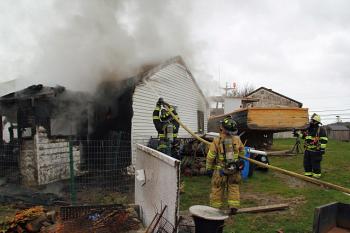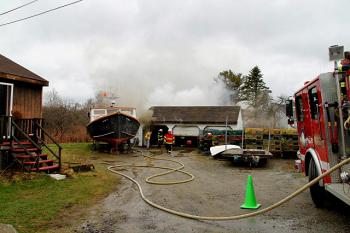Fire kills chicks, burns chicken coop in Owls Head Tuesday
OWLS HEAD — A heat lamp inside an Owls Head chicken coop is the likely cause of a fire late Tuesday morning, which killed a hen and four newly acquired chicks inside.
Owls Head Fire Chief Frank Ross credited a strong mutual aid response from Rockland and South Thomaston with assisting Owls Head firefighters in quickly putting out the fire before it consumed a garage, located just a few feet away from the chicken coop.
Ross said the fire caused about $5,000 to $7,000 damage, destroying the coop and burning the back wall of the garage. Contents inside the garage and its workshop sustained water and smoke damage.
The fire was at the Bayside West residence of Janis and Bert Philbrick, and it was Janis who was home and called in the fire, according to Ross.
Ross said the Philbricks had just purchased the chicks from Tractor Supply a few days ago.
This is a popular time of year for acquiring and raising baby chickens, ducks, geese and guinea hens, and here is some advice about heat lamps and fire safety.
Chicks and other young birds need to be kept very warm at first, around 90-95 degrees Fahrenheit, until they have lost their fluff and grown a full set of feathers to keep themselves warm. That can take between four and five weeks, depending on how the chicks are kept, either indoors or in an outdoor coop, and how long the chicks adapt to a slow lowering of the temperature to ambient.
For many, the best heat source for their new chicks is a mother hen. But for others, including those just getting started raising chickens, a heat source in the form of a clamping brooding lamp, is the next best choice.
According to Hope Fire Chief Clarence Keller, and Jodi Barton, both of Rankin's Hardware, brooding lamps should be used with a 250-watt, 120-volt brooding bulb to produce adequate heat for chicks.
“Unlike standard clamp lamps with plastic sockets, a brooding clamp lamp has a porcelain socket,” said Barton. And the metal reflective shield disperses the heat from the red bulb, whereas a standard clamp light’s shield reflects the light. Some standard and brooder lamps also come with a cage over the reflector pan, but an inadequately clamped brooder lamp will spell disaster if it falls onto straw, shavings or live chicks.
Standard clamp lamps usually take a maximum 120-watt bulb, whereas a brooder bulb is 250 watts, and Keller said he would be wary of putting even the 120-watt bulb into a plastic socket.
"The porcelain socket typically has a higher heat rating than the standard clamp lamp,” said Keller. “And it's important to consider the extension cord being used too. It needs to be rated to be safe for the 250-watt bulb at the proper length of the cord you intend to use."
Rankin’s is hosting a free workshop, Flock Talk, at its Camden store on Union Street tonight, April 19, at 6 p.m. These tips and others will be topics of discussion. Registration is recommended by calling 236-3275.
Reach Editorial Director Holly S. Edwards at hollyedwards@penbaypilot.com and 207-706-6655.
























